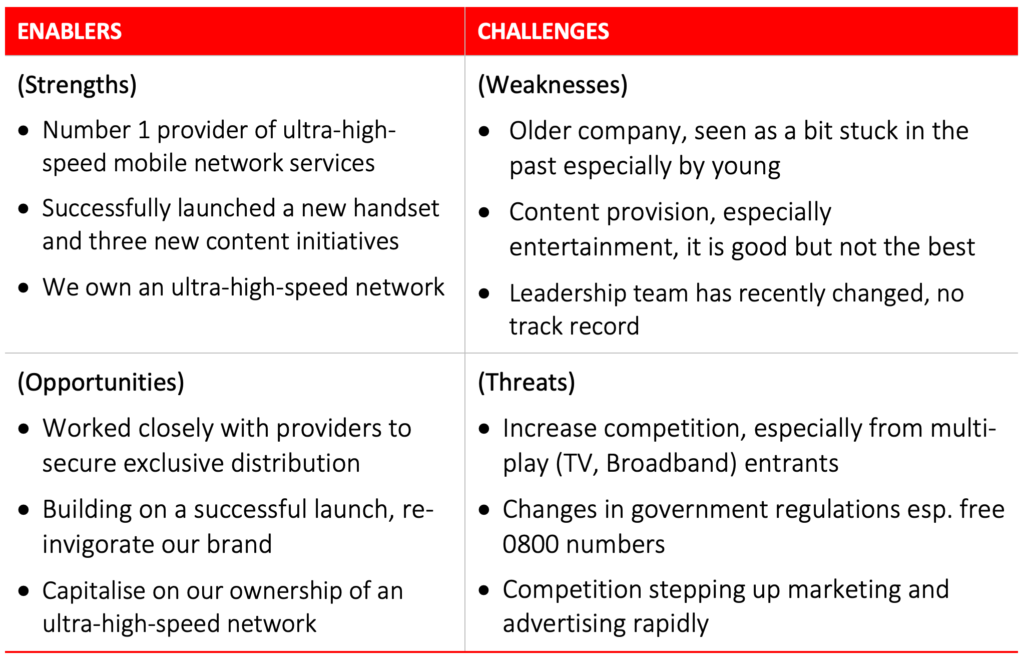What is SWOT? – We continue our article series that looks at strategic management and some of the useful strategic tools that exist to help take their strategic processes forwards.
Previously, we looked at the popular PESTLE tool. Today we will turn our attention to perhaps one of the best-known strategic tools of all; the SWOT. Recognised by business students, managers and entrepreneurs everywhere, the SWOT tool is another mnemonic which stands for Strengths, Weaknesses, Opportunities and Threats.
SWOT diagram
SWOT is usually drawn as a four-box diagram, and each of the quadrants has a short statement. Once populated with information, the resulting diagram can be read in different ways. By reading from left to right, the information shows both an internal and external focus of the organisation. And by reading downwards, enablers and challenges are shown in focus. For example:
Example of a SWOT diagram
The overall diagram exists to show a single, overall position in one view. A SWOT diagram may be simple, but it will usually house plenty of rich analysis and thought which provokes plenty of discussion and further analysis. For example:
Strengths
The business can ask what advantages it has against its competitors, and what it can do that will likely generate the best ROI. It will look at what it does best overall, and consider whether or not it is missing out on any obvious wins. Where it can see evident strengths that it isn’t currently exploiting within its market, it will consider whether any could be rapidly leveraged for gains.
Weaknesses
Here, the organisation will look at areas where it could improve. It will ask whether it is worthwhile to improve these weak areas, or whether they should be avoided entirely. Customer feedback will be reviewed to ascertain where complaint themes emerge and the same will be done for employee feedback. Processes will also be reviewed to highlight any weak spots which are slow or ineffective.
Opportunities
The business will look out for obvious opportunities here as well as potential trends in the marketplace – both immediate and for the longer-term. Possible trends to exploit will be identified here, including those that affect population, lifestyle or social factors.
Threats
This is an important quadrant to fill in order to anticipate external threats and obstacles. Business leaders will identify what competitors are doing and whether any forms of regulatory, government or technological change are on the horizon, which could impact the business. Other key areas to consider for potential threats include supplier relationships or access to talented recruitment markets for a steady supply of great talent.
How SWOT analyses can be used
This very useful strategic tool can be used in two main ways.
- The SWOT can form part of the strategic management process to structure serious and thorough analysis.
- As a ‘warm-up’ to kick-off a broader programme of analysis. For example, it could be used by subject matter experts in the business to deeply analyse a certain area and to generate detailed insight. In this type of scenario, it could be used as part of an optioneering process for further consideration; perhaps to plan a new product launch or marketing campaign or to consider an operational process adjustment or software investment.
Pros and cons of SWOT analysis
As with any tool or model, the SWOT has advantages:
- It effectively condenses large volumes of data into a simple, manageable view for simplification. This makes it easy for readers to see the big picture, whilst being able to identify fine detail.
- It’s possible to identify the main opportunities and threats for any market. This simple analytical tool is also fully scalable, meaning that data can be expanded to any level – from local through to international.
- It also links to other useful tools – such as the PESTLE tool and strategic tools that we will discuss in further detail in our article series.
However, care must be taken because:
- It’s possible to oversimplify with a SWOT analysis, especially if there is a need to simplify complex issues for certain stakeholder groups. Necessary detail can be lost if this happens.
- There can also be a danger that objectivity gets lost, especially where individuals contributing to the SWOT let their own natural bias or vested interests come to the fore. One way to avoid this from occurring is to develop the SWOT as part of a strategic process moderated by an external facilitator.
- Without real limits, it can be hard to identify the factors which are likely to be relevant or irrelevant within the SWOT. It’s also important to remember that the analysis will naturally only include known factors. Decision-makers must always remember that unknown factors are both likely to be present in a given market and able to influence the business in unexpected ways. This is one primary reason why business strategies tend to evolve over time.
- Validity can also be a concern, as the tool includes no requirement to verify statements for accuracy.
However, as long as the organisation using the SWOT can bear these potential limiting factors in mind, the tool can be very useful indeed, especially when used as part of a wider suite of strategic analysis tools.
Find out more
Interested in learning more about SWOT analysis and the strategic management process? Please contact the Intrafocus team to find out more. We can run a strategy workshop on your premises, tailored to your business and industry – and run by highly qualified and experience strategy facilitators.



